This view of the Owner's Manual contains the very latest information, which may vary slightly from the printed Owner's Manual originally provided with your vehicle. It may also describe content that is not on or operates differently on your vehicle. Please consider the Owner's Manual originally provided with your vehicle as the primary source of information for your vehicle.
The information contained in this publication was correct at the time of release.In the interest of continuous development, we reserve the right to change specifications, design or equipment at any time without notice or obligation.No part of this publication may be reproduced, transmitted, stored in a retrieval system or translated into any language in any form by any means without our written permission.Errors and omissions excepted.
Copyright © 2024 Ford Motor Company
Tire Sealant and Inflator Kit
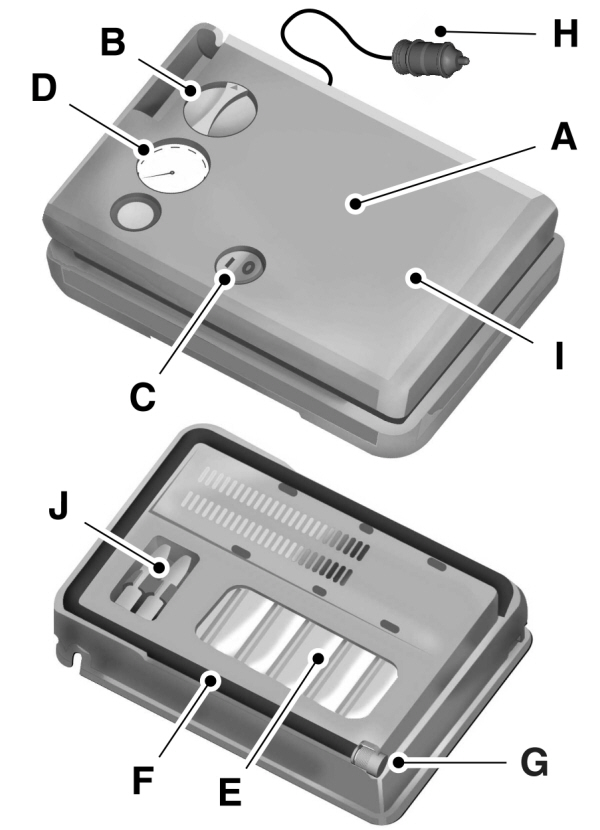
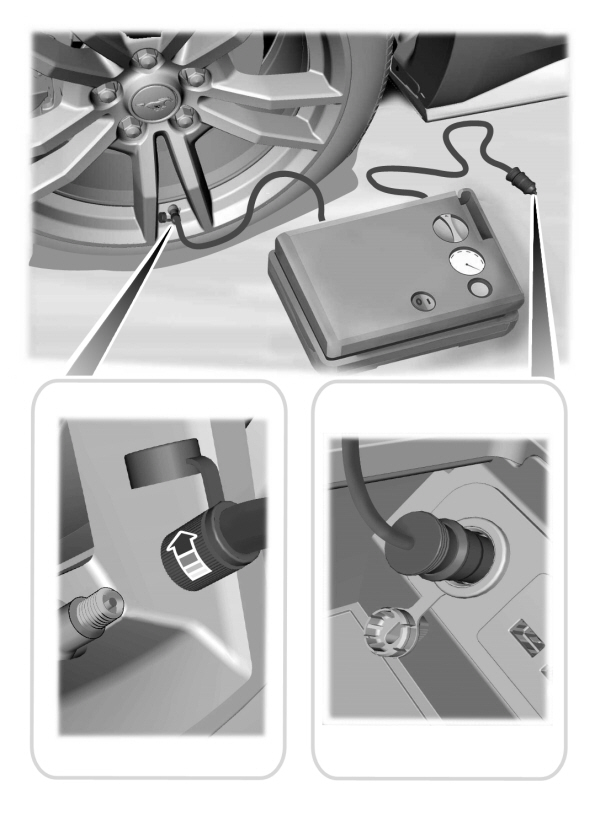
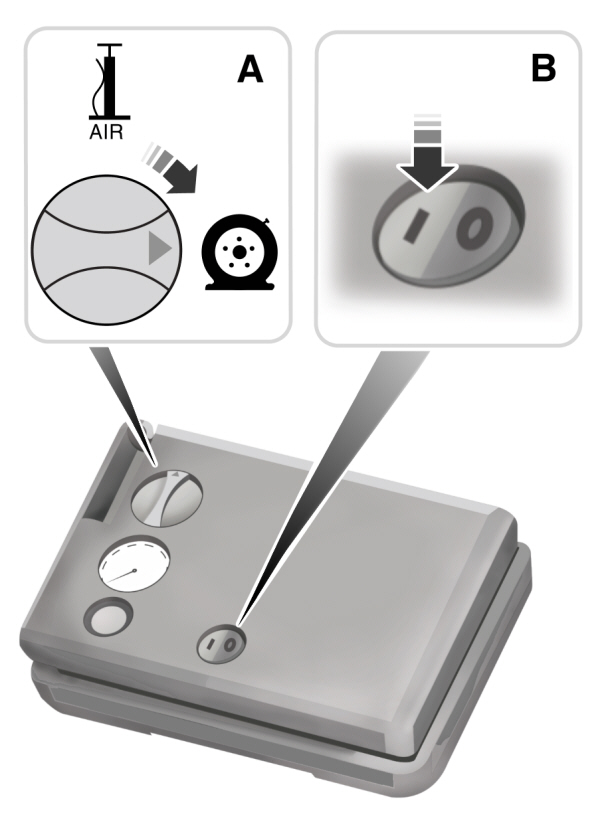
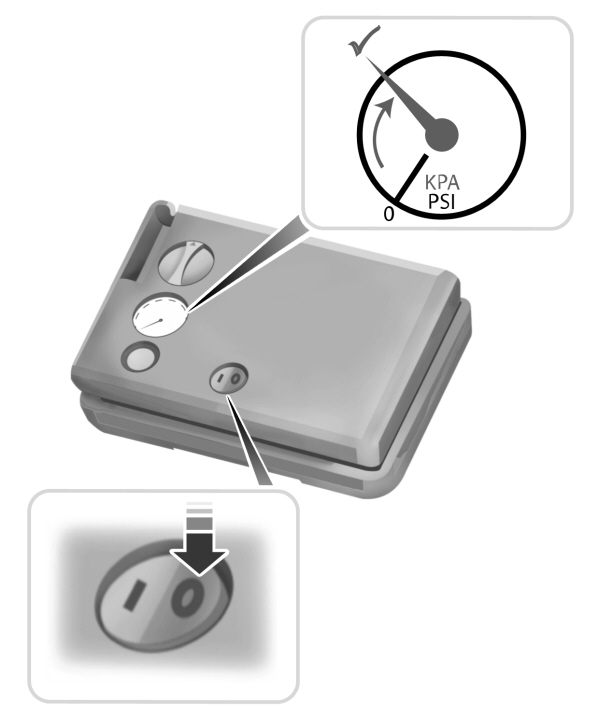
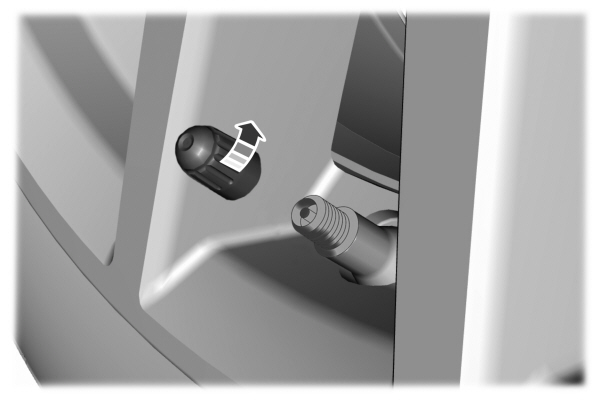



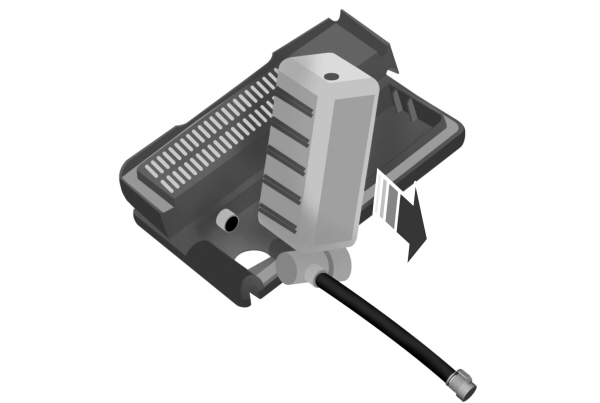

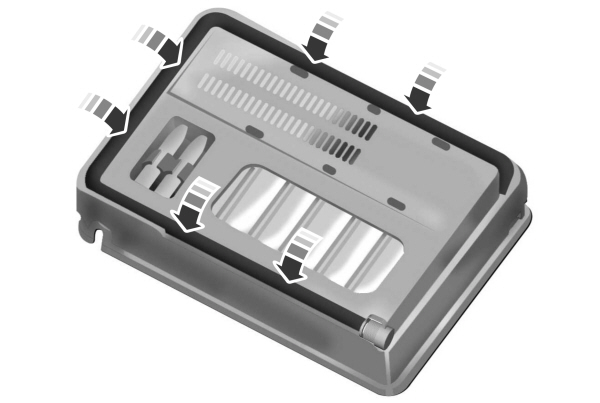
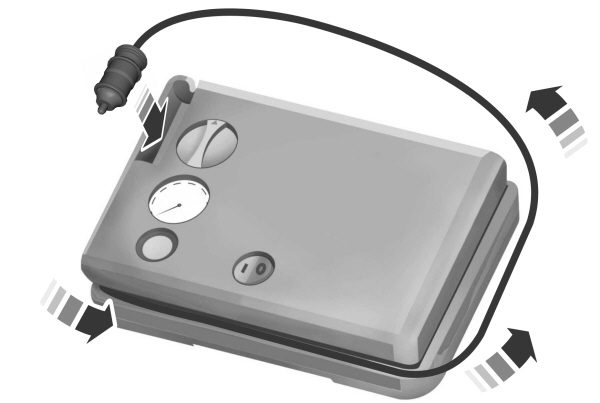
Note:
The temporary mobility kit contains enough sealant compound in the canister for one tire repair only. See an authorized Ford dealer for replacement sealant canisters.
The kit is located in the luggage compartment.
The kit consists of an air compressor to reinflate the tire and a canister of sealing compound that will effectively seal most punctures caused by nails or similar objects. This kit provides a temporary tire repair, allowing you to drive your vehicle up to
120 mi (200 km) at a maximum speed of
50 mph (80 km/h) to reach a tire service location.

| A B C D E F G H I J |
General Information
 WARNING:
Failure to follow these guidelines could result in an increased risk of loss of vehicle control, injury or death.
WARNING:
Failure to follow these guidelines could result in an increased risk of loss of vehicle control, injury or death. |
Note:
Do not use the kit if you have severely damaged a tire. Only seal punctures located within the tire tread with the kit.
Do not attempt to repair punctures larger than ¼ inch (6 millimeters) or damage to the tire's sidewall. The tire may not completely seal.
Loss of air pressure may adversely affect tire performance. For this reason:
Note:
Do not drive the vehicle above
50 mph (80 km/h).
Note:
Do not drive further than
120 mi (200 km). Drive only to the closest authorized Ford dealer or tire repair shop to have your tire inspected.
- Drive carefully and avoid abrupt steering maneuvers.
- Periodically monitor tire inflation pressure in the affected tire; if the tire is losing pressure, have the vehicle towed.
- Read the information in the Tips for Use of the Kit section to make sure safe operation of the kit and your vehicle occurs.
Tips for Use of the Kit
To ensure safe operation of the kit:
- Read all instructions and cautions fully.
- Before operating the kit, make sure your vehicle is safely off the road and away from moving traffic. Switch on the hazard lights.
- Always set the parking brake to make sure the vehicle does not move unexpectedly.
- Do not remove any foreign objects, such as nails or screws, from the tire.
- When using the kit, leave the engine running (only if the vehicle is outdoors or in a well-ventilated area) so the compressor does not drain the vehicle's battery.
- Do not allow the compressor to operate continuously for more than 15 minutes. This will help prevent the compressor from overheating.
- Never leave the kit unattended during operation.
- Sealant compound contains latex. Those with latex sensitivities should use appropriate precautions to avoid an allergic reaction.
- Keep the kit away from children.
- Only use the kit when the ambient temperature is between -22 °F (-30 °C) and 158 °F (70 °C).
- Only use the sealing compound before the use-by date. The use-by date is on a label on the sealant canister, which you can see through the rectangular viewing window on the bottom of the compressor. Check the use-by date regularly and replace the canister after four years of non-use.
- Do not store the kit unsecured inside the passenger compartment of the vehicle as it may cause injury during a sudden stop or crash. Always store the kit in its original location.
- After sealant use, an authorized Ford dealer must replace the tire pressure monitoring system sensor and valve stem on the wheel.
- Operating the kit could cause an electrical disturbance in radio, CD and DVD player operation.
 * When inflation only is required for a tire or other objects, the selector must be in the Air position.
* When inflation only is required for a tire or other objects, the selector must be in the Air position. |
What to Do When a Tire Is Punctured
Repair a tire puncture within the tire's tread area in two stages with the kit.
- In the first stage, inflate the tire with a sealing compound and air. After you inflate the tire, you will need to drive the vehicle a short distance (about 4 miles [6 kilometers]) to distribute the sealant in the tire.
- In the second stage, check the tire pressure and adjust, if necessary, to the vehicle's specified tire inflation pressure.
First Stage: Inflating the Tire with Sealing Compound and Air
 WARNING:
Do not stand directly over the kit while inflating the tire. If you notice any unusual bulges or deformations in the tire's sidewall during inflation, stop and call roadside assistance.
WARNING:
Do not stand directly over the kit while inflating the tire. If you notice any unusual bulges or deformations in the tire's sidewall during inflation, stop and call roadside assistance. WARNING:
If the tire does not inflate to the recommended tire pressure within 15 minutes, stop and call roadside assistance.
WARNING:
If the tire does not inflate to the recommended tire pressure within 15 minutes, stop and call roadside assistance. WARNING:
Do not run the engine during kit operation unless the vehicle is outdoors or in a well-ventilated area.
WARNING:
Do not run the engine during kit operation unless the vehicle is outdoors or in a well-ventilated area. |
Preparation: Park the vehicle in a safe, level and secure area, away from moving traffic.
Switch the hazard lights on. Apply the parking brake and switch the engine off. Inspect the flat tire for visible damage.
Sealant compound contains latex. Use appropriate precautions to avoid any allergic reactions.
Do not remove any foreign object that has pierced the tire. If a puncture is located in the tire sidewall, stop and call roadside assistance.
- Remove the valve cap from the tire valve.
- Unwrap the dual purpose hose (black tube) from the back of the compressor housing.
- Fasten the hose to the tire valve by turning the connector clockwise. Tighten the connection securely.

- Plug the power cable into the 12-volt power point in the vehicle.
- Remove the warning sticker found on the canister and place it on the top of the instrument panel or the center of the dash.
- Start the vehicle and leave the engine running so the compressor does not drain the vehicle’s battery.

- Turn dial (A) clockwise to the sealant position. Switch the kit on by pressing the on/off button (B).
- Inflate the tire to the pressure listed on the tire label located on the driver door or the door jamb area. The initial air pressure gauge reading may indicate a value higher than the label pressure while you pump the sealing compound into the tire. This is normal and should be no reason for concern. The pressure gauge reading will indicate the tire inflation pressure after about 30 seconds of operation. You should check the final tire pressure with the compressor turned OFF in order to get an accurate pressure reading.

- When the tire reaches the recommended tire pressure, switch off the kit, unplug the power cable, and disconnect the hose from the tire valve. Re-install the valve cap on the tire valve and return the kit to the stowage area.
- Immediately and cautiously, drive the vehicle 4 miles (6 kilometers) to distribute the sealant evenly inside the tire. Do not exceed 50 mph (80 km/h).
- After 4 miles (6 kilometers), stop and check the tire pressure. See Second Stage: Checking Tire Pressure.
Note:
If you experience any unusual vibration, ride disturbance or noise while driving, reduce your speed until you can safely pull off to the side of the road to call for roadside assistance.
Note:
Do not proceed to the second stage of this operation.
Second Stage: Checking Tire Pressure
 WARNING:
If you are proceeding from the First stage: Re–inflating the tire with sealing compound and air section and have injected sealant in the tire and the pressure is below
20 psi (1.4 bar), stop and call roadside assistance. If tire pressure is above
20 psi (1.4 bar), continue to the next step.
WARNING:
If you are proceeding from the First stage: Re–inflating the tire with sealing compound and air section and have injected sealant in the tire and the pressure is below
20 psi (1.4 bar), stop and call roadside assistance. If tire pressure is above
20 psi (1.4 bar), continue to the next step. WARNING:
The power plug may get hot after use and should be handled carefully while unplugging.
WARNING:
The power plug may get hot after use and should be handled carefully while unplugging. |
Check the air pressure of your tires as follows:

- Remove the valve cap from the tire valve.
- Firmly screw the air compressor hose onto the valve stem by turning clockwise.
- Push and turn the dial clockwise to the air position.
- If required, switch on the compressor and adjust the tire to the recommended inflation pressure shown on the tire label located on the driver's door or door jamb area. You should check the tire pressure with the compressor turned OFF in order to get an accurate pressure reading.
- Unplug the hoses, re-install the valve cap on the tire and return the kit to the stowage area.
What to Do After the Tire has Been Sealed
After using the kit to seal your tire, replace the sealant canister and clear tube (hose). Obtain and replace the sealing compound and spare parts at an authorized Ford Motor Company dealership or tire dealer. You can dispose empty sealant bottles at home. However, return the liquid residue from the sealing compound to an authorized dealer or tire dealer for disposal, or in accordance with local waste disposal regulations.
Note:
After you use the sealing compound, the maximum vehicle speed is
50 mph (80 km/h) and the maximum driving distance is
120 mi (200 km). Inspect the sealed tire immediately.
Check the tire pressure any time within the
120 mi (200 km) by performing the steps listed previously in the Second Stage: Checking Tire Pressure procedure.
Removal of the Sealant Canister from the Kit

- Unwrap the dual purpose hose (black tube) from the compressor housing.

- Unwrap the power cord.

- Remove the back cover.

- Rotate the sealant canister up 90 degrees and pull away from casing/housing to remove.
Installation of the Sealant Canister to the Kit
- With the canister held perpendicular to the housing, insert the canister nozzle into the connector and push until seated.
- Rotate the canister 90 degrees down into the housing/casing.

- Snap the back cover back into place.

- Wrap the dual purpose hose (black tube) around the channel on the bottom of the housing/casing.

- Wrap the power cord around the housing and stow the accessory power plug into its storage area.
Note:
If you experience any difficulties when you remove or install the sealant canister, contact your authorized Ford dealer for assistance.
Make sure you check the sealant compound’s use-by date regularly. The use-by date is on a label located on the sealant canister, which you can see through the rectangular viewing window on the bottom of the kit. Replace the sealant canister after four years of non-use.
Thank You For Your Feedback
